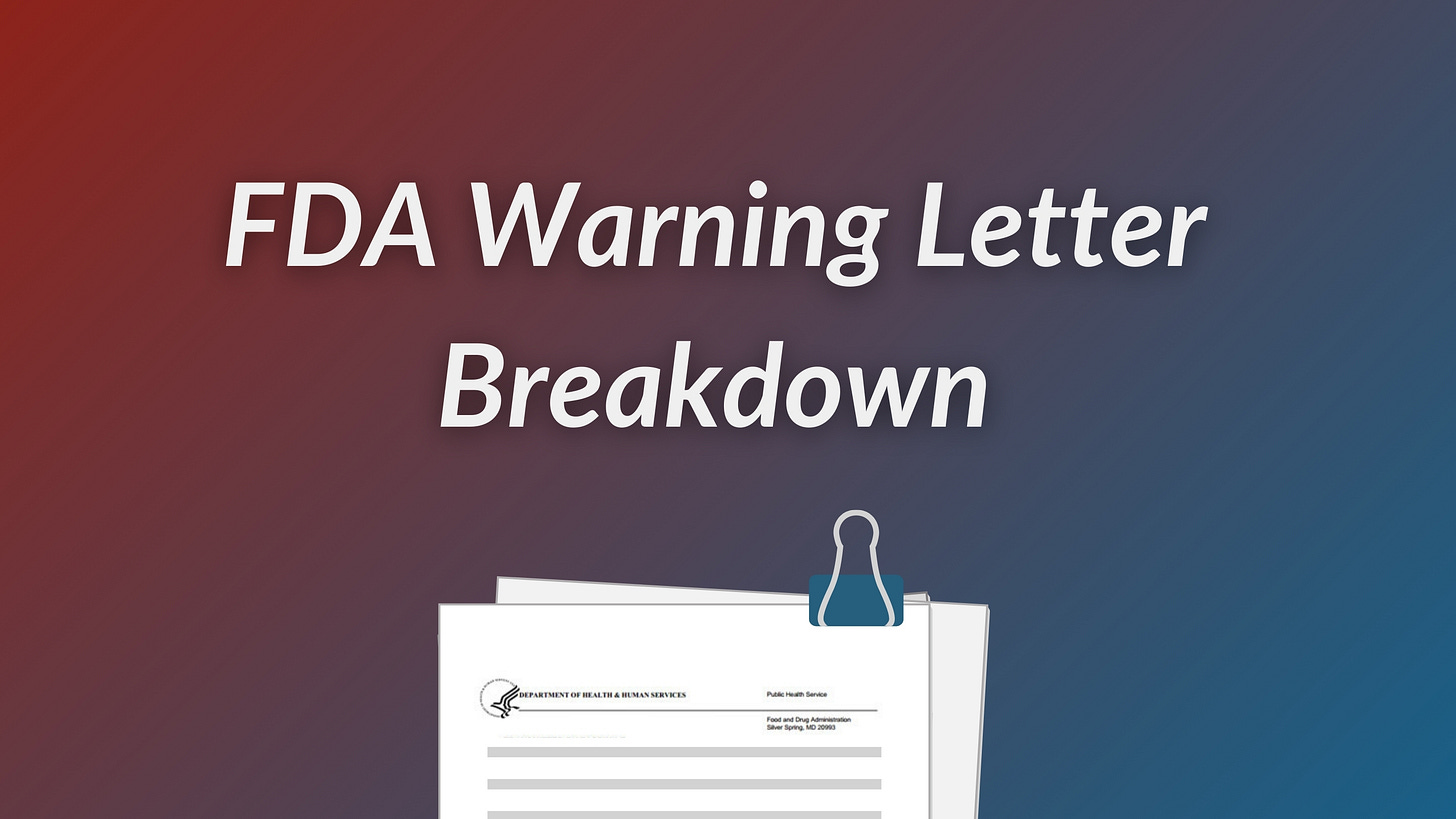Inside 3 FDA Warning Letters: The Recurring CGMP Violations That Triggered Import Alerts
International manufacturing sites face import alerts as FDA identifies systemic quality failures in China and India.
This breakdown is available for paid subscribers. Only paid subscribers get regular full access to our breakdowns and other analyses. If you’re not already a paid subscriber, you can upgrade here.
The FDA’s CDER recently posted three warning letters revealing persistent problems in pharma manufacturing facilities in China and India. These letters give some valuable insight into the agency's enforcement priorities and highlight critical areas where manufacturers continue to stumble. We see these issues come up in our own audit work, too.
The warnings target two Chinese manufacturers of OTC drug products and one Indian API manufacturer. Despite their different operations and locations, these facilities share alarming similarities in their quality system deficiencies.
Read them all in full here:
Here’s a quick and practical look at the common problem areas and a few questions for self-assessment on each point.
Want to stay out of our warning letter breakdowns? Contact us for audit, mock inspection, remediation, and other RA/QA support.
1. Quality control/unit failures
Quality Units at all three facilities failed to exercise their basic responsibilities:
"Your firm's quality control unit failed to exercise its responsibility to ensure drug products manufactured are in compliance with CGMP, and meet established specifications for identity, strength, quality, and purity."
One Quality Unit approved products for distribution that were "not supported by appropriate original data."
"Based on the records and information you provided, you did not demonstrate you conducted adequate finished drug product testing on your drug products before releasing them for distribution."
The FDA emphasized that "testing is essential to ensure that the drug products you manufacture conform to all pre-determined quality attributes appropriate for their intended use." Without adequate testing, manufacturers simply don't know whether their products are suitable for release.
2. Data integrity issues
Arguably, the most concerning were the widespread data integrity violations that undermine the very foundation of pharmaceutical QA.
"The use of correction fluid (white-out) was also observed to make corrections on paper records documenting microbial analyses of finished products and raw materials."
"You provided a written statement on firm letterhead admitting to backdating a QC lab document and you signed a declaration confirming commercial drugs shipped to the US were not supported by appropriate original data."
"Your batch production records lacked documentation that each significant step in the manufacture, processing, packing, or holding of the batch was accomplished."
In one particularly concerning example, a manufacturer confirmed that "original data, including balance printout slips, times, sample preparations, and equipment logs were not maintained." Without this data, manufacturers cannot demonstrate their products meet specifications.
3. Inadequate component testing
All three manufacturers failed to properly test incoming components — a critical step in ensuring product quality and safety.
"Your firm used results from your suppliers' certificates of analysis (COAs) without establishing the reliability of your suppliers' analyses through appropriate validation and without conducting at least one specific identity test on each incoming lot of components."
One firm was observed to be producing "higher-risk APIs in an inadequate facility including one that lacks appropriate separation for high pharmacological activity or toxic materials."
"You did not demonstrate you adequately performed identity testing on incoming components including, but not limited to, glycerin and propylene glycol, which are at high-risk of diethylene glycol (DEG) or ethylene glycol (EG) contamination."
The FDA emphasized that "the use of ingredients contaminated with DEG or EG has resulted in various lethal poisoning incidents in humans worldwide" — highlighting just how critical proper component testing is to patient safety.
4. Poor stability programs
None of the manufacturers could demonstrate their products would remain within specifications throughout their claimed shelf life:
One firm failed to "ensure an adequate stability program (including assessment of product potency over the shelf life) to support your claimed (b)(4) expiry for (b)(4) drug products."
"Your firm does not have adequate data to support the retest date for drugs shipped to the United States."
"You did not include active ingredient testing as part of your stability program."
As the FDA noted, "without appropriate stability studies, you do not have scientific evidence to support whether your drug products meet established specifications and retain their quality attributes through their labeled expiry."
Regulatory consequences
All three manufacturers faced serious regulatory consequences for these violations:
Yangzhou Sion Commodity: "FDA placed products offered for import into the United States from your firm on Import Alert 66-40 on January 31, 2025."
Aspen Biopharma Labs: "FDA placed drugs offered for import into the U.S. from your firm on Import Alert 66-40 on January 15, 2025." Additionally, this manufacturer "initiated a voluntary nationwide recall on February 7, 2025, of all products distributed in the United States."
Hangzhou Glamcos Biotech: "FDA placed your firm on Import Alert 66-40 on September 30, 2024."
A few questions for self-assessment
Having worked with pharma teams on auditing, mock inspection, gap analysis, and remediation support, we can say that these warning letters highlight several critical areas where we find companies commonly fall short.
Ask yourself the following questions and contact us if you don’t know or don’t like your answers to any of them.
Component testing integrity: Are you testing each lot of high-risk components (particularly those susceptible to diethylene glycol/ethylene glycol contamination) using validated USP methods that specifically identify harmful impurities, rather than simply accepting supplier COAs?
Data documentation: If FDA investigators reviewed your lab books, batch records, and electronic systems today, would they find any instances of backdating, use of correction fluid, destruction of original data, or missing documentation between equipment printouts and official records?



